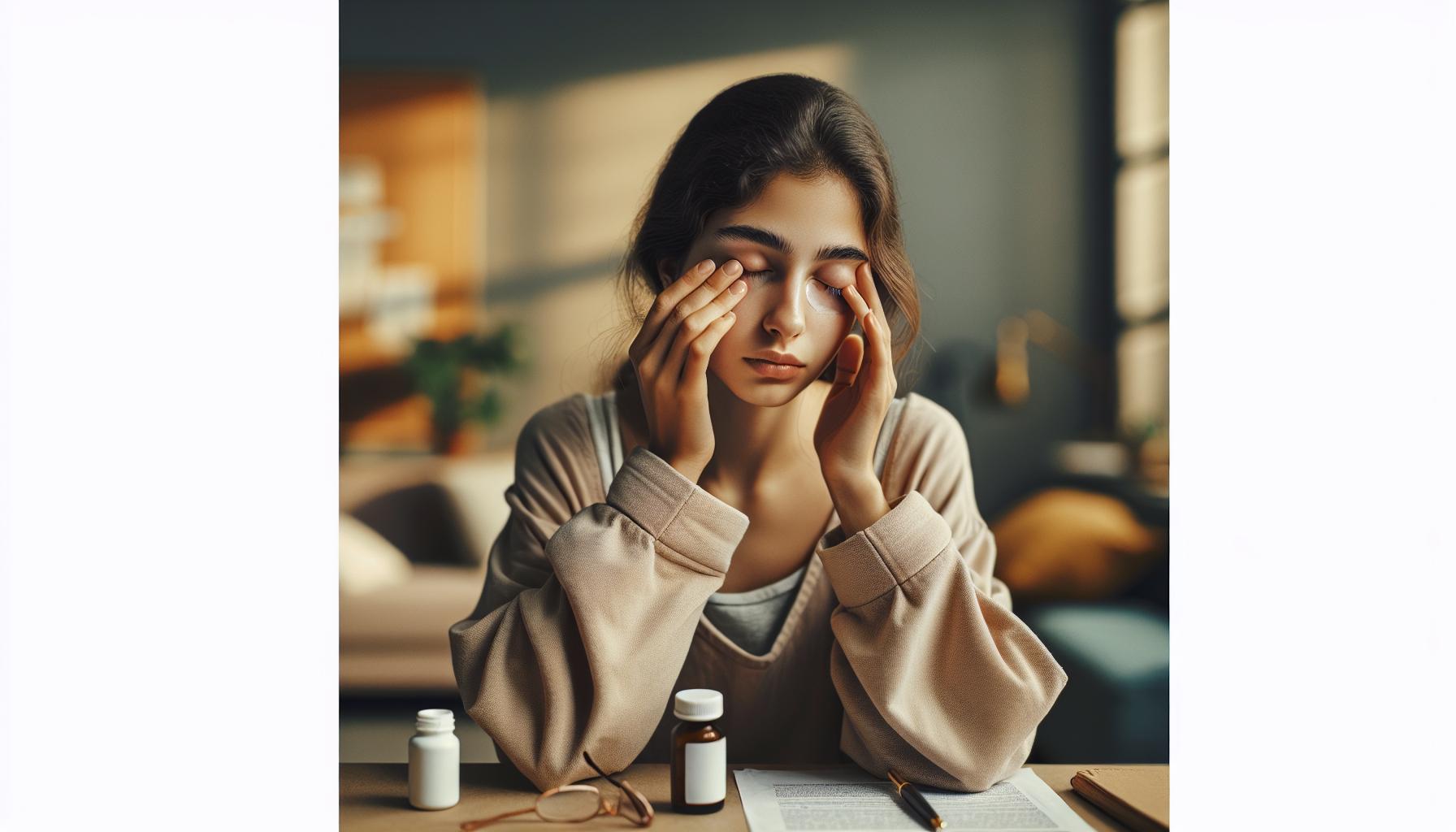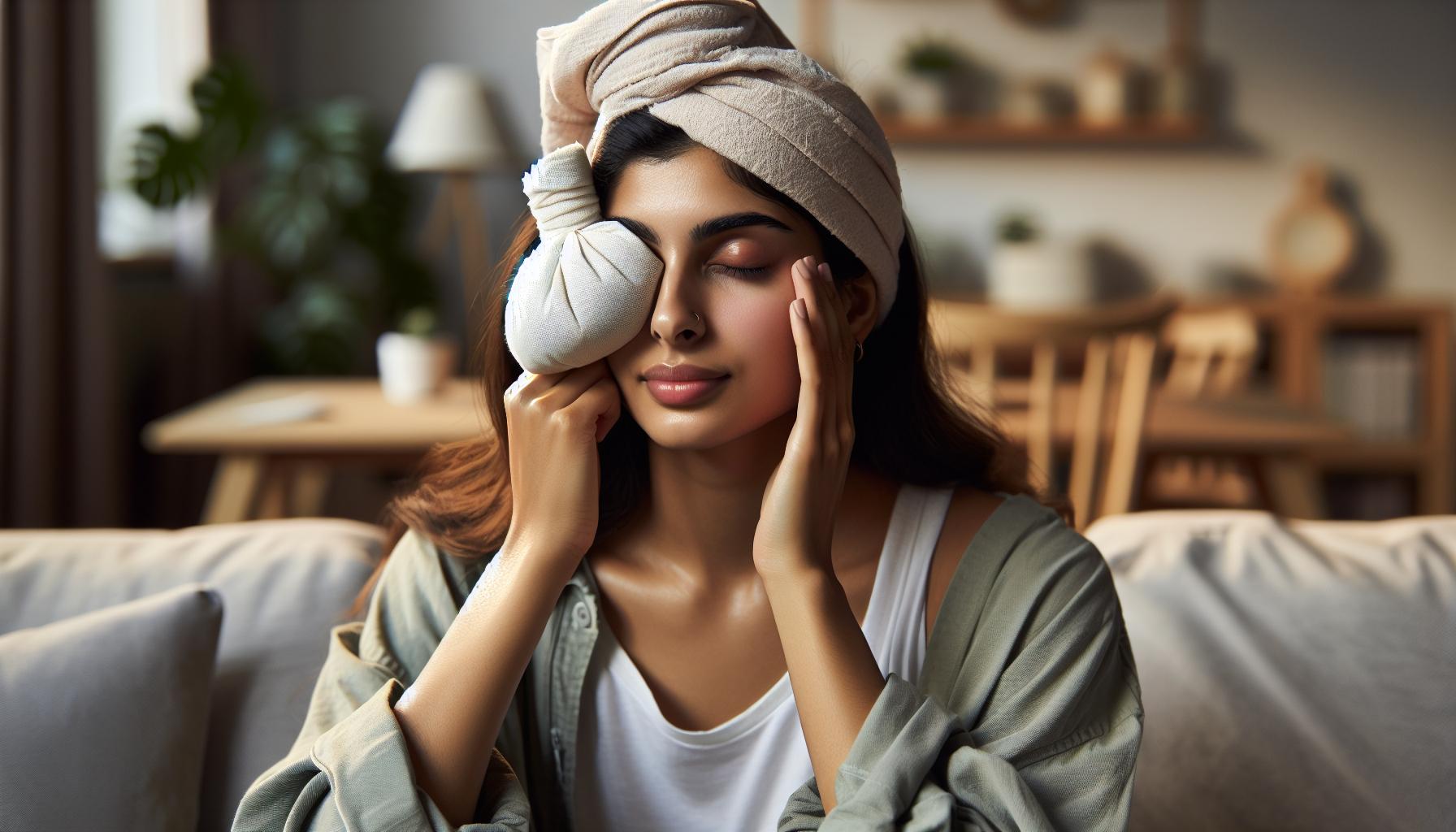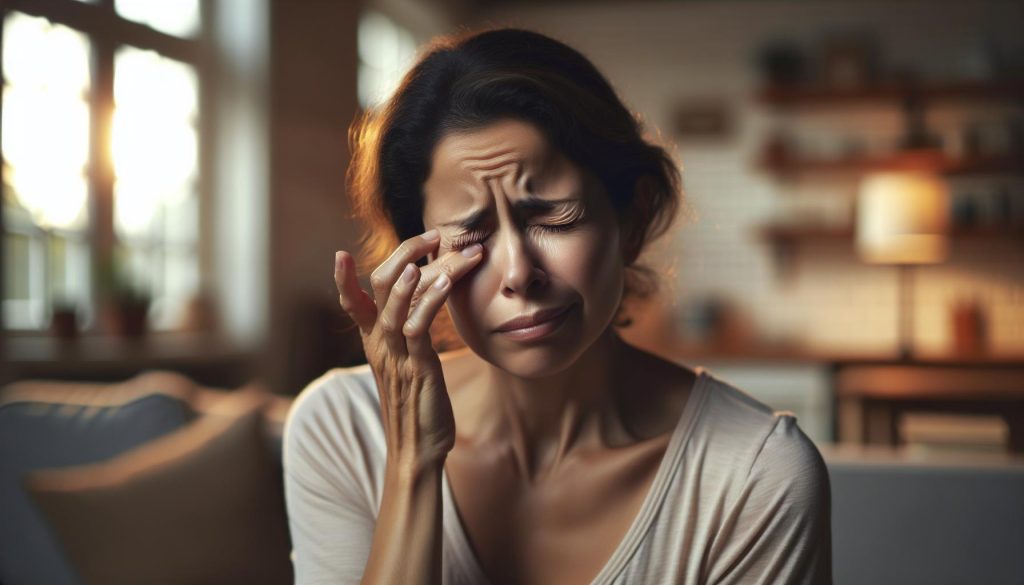A stye, that irritating bump on your eyelid, can go beyond discomfort-it’s often your body’s way of signaling something more significant. Did you know that your eyes can reflect your overall health? When faced with a stye, many wonder if it could lead to feelings of sickness or fatigue. Understanding this connection is essential, as it can help you better identify and respond to your body’s alerts, ensuring you don’t overlook other health issues.
In this article, we’ll explore the symptoms of a stye, how they may relate to illnesses, and what they signify about your general wellbeing. Recognizing these body signals empowers you to take proactive steps toward your health, whether that means seeking treatment or adopting preventive measures for the future. Let’s delve into the intriguing relationship between eye health and overall wellness, so you can feel informed and confident in your choices.
Symptoms of a Stye: Is It More Than Just Pain?
A stye can be more than just a painful lump on your eyelid; it can signal a range of bodily responses that may make you feel unwell. Typically characterized by a red, swollen bump along the eyelid, a stye is often accompanied by discomfort, sensitivity to light, and tearing. While the primary sensation is one of localized pain, many individuals report an overall feeling of malaise. This could stem from the body’s inflammatory response, as the immune system reacts to the bacteria causing the stye. It’s not uncommon to feel tired or find it hard to concentrate due to the discomfort and distraction that the stye brings, which can affect day-to-day activities.
In some cases, symptoms may extend beyond local pain. For instance, you might experience a headache or a feeling of pressure around your eyes. Such sensations can be caused by the body’s natural response to infection or inflammation. In rare instances, if the infection spreads or if you have a pre-existing condition that affects your immune response, you may experience systemic symptoms, such as fever or fatigue. Understanding these connections can empower you to recognize when a seemingly straightforward stye might be indicative of something that requires medical attention. Remember, while many styes resolve with basic self-care, it’s vital to listen to your body and consult a healthcare provider if your symptoms worsen or persist.
Understanding the Connection Between Styes and Systemic Illness
Experiencing a stye can feel like a minor annoyance, but it’s important to recognize how this seemingly localized issue can be intertwined with your overall health. While a stye primarily presents as a painful, red bump on the eyelid due to a blocked gland, it can be a signal from your body that there’s more happening beneath the surface. Understanding this connection can empower you to take more informed steps toward your health.
When your body fights off the infection causing the stye, it often mounts an inflammatory response. This goes beyond the eyelid and can lead to systemic symptoms, which may include fatigue, headaches, and in some cases, even feelings of general malaise. People with pre-existing conditions, particularly those affecting the immune system, may notice these effects more acutely. For instance, if you typically have a strong immune response but suddenly feel run down during a stye outbreak, it might serve as a reminder to prioritize rest and self-care while your body heals.
It’s also essential to consider psychological factors. The discomfort and distraction caused by a stye can make daily activities feel more challenging, leading to heightened stress levels that might compound that fatigue. Listening to your body’s signals can be vital. If you notice any significant changes-such as a persistent fever, vision changes, or severe headaches-it’s wise to consult a healthcare provider.
Recognizing that a stye is not merely an isolated incident, but rather a signal from your body that may reflect broader health concerns, is key. By understanding this connection, you are better equipped to care for yourself holistically, ensuring both your eye health and overall wellness are prioritized.
When to Seek Medical Attention for a Stye
Experiencing a stye can be uncomfortable, but it’s crucial to know when to take the next steps for your health. While many styes are benign and can resolve with basic care, certain signs warrant professional medical attention to prevent complications or address underlying health issues.
Seek medical attention promptly if you encounter any of the following symptoms:
- Persistent Swelling: If the swelling around the stye worsens or spreads beyond the eyelid.
- Vision Changes: Any alteration in your ability to see clearly, including blurriness or double vision, should not be ignored.
- Severe Pain: An increase in pain that disrupts your daily activities might indicate a more serious issue, such as an abscess.
- Fever: A high fever accompanying a stye can signal an infection that requires medical intervention.
- Frequent Recurrences: If you find yourself experiencing styes regularly, it could point to underlying conditions, such as issues with your immune system or hygiene practices.
In some cases, a stye might develop into a chalazion, which can be painless but lead to discomfort and swelling if not treated. Consult your healthcare provider if a stye persists longer than a week or if it does not respond to home treatments like warm compresses, which can usually provide relief.
The emotional toll of living with discomfort can amplify feelings of anxiety and stress. Addressing these feelings is just as important as treating the physical aspects of a stye. Communicating openly with your healthcare provider will aid in comprehensive care, ensuring that every aspect of your well-being is considered and managed effectively. Prioritizing your health includes being mindful of these symptoms and not hesitating to reach out for help.
Home Remedies: Soothing a Stye and Associated Symptoms
A stye can be more than just a painful nuisance; it can also make you feel unwell overall. Fortunately, there are several soothing home remedies that can help alleviate the discomfort associated with a stye, enhancing your recovery and improving your overall well-being. One of the most effective and accessible methods is the use of warm compresses. Simply soak a clean washcloth in warm-not hot-water, wring it out, and place it gently over the affected eyelid for about 10 to 15 minutes. This can help reduce swelling and promote drainage of the stye while providing a comforting sensation.
Additionally, natural ingredients can play a supportive role in your healing process. For instance, chamomile tea bags, once cooled, can be placed over the eye as a compress. Chamomile has anti-inflammatory properties that may help soothe irritated areas. Similarly, a diluted mixture of apple cider vinegar and water can be applied around the stye to help prevent further infection; however, take care to avoid contact with the eye itself.
It’s also essential to practice good hygiene. Always wash your hands before touching your face or eye area, and avoid squeezing or popping the stye, as this can worsen the infection. If makeup is part of your daily routine, it may be wise to avoid eye cosmetics during this time to prevent further irritation. Incorporating these home remedies into your daily care can not only help soothe a stye but also support your overall eye health, allowing you to feel more comfortable and in control of your situation.
Finally, while home remedies can be extremely effective, it’s vital to remember that persistent symptoms or significant discomfort may warrant a visit to your healthcare provider to rule out any underlying issues. By paying attention to your body signals and taking proactive steps, you can better navigate the challenges a stye presents.
Debunking Myths: Do Styes Cause Fever or Illness?
Understanding the impact of a stye on your overall well-being can help dispel common misconceptions. Many people wonder if a stye can lead to more serious symptoms like fever or illness. Fortunately, styes are typically localized infections and do not usually cause systemic symptoms such as fever. They are a result of a bacterial infection in the oil glands of the eyelid, leading to inflammation and discomfort; however, they generally do not trigger broader health issues.
That said, the pain and swelling from a stye can make you feel unwell. It’s not uncommon for someone with a stye to experience fatigue or a general sense of malaise due to discomfort. If you are feeling particularly fatigued or unwell, it might be more attributable to anxiety around the stye or the inconvenience it causes rather than the stye itself.
Moreover, it’s essential to know the signs that could indicate a more serious condition. If you develop a fever or notice increasing redness or swelling, these could be indications of a more severe infection, and it would be wise to consult a healthcare professional. Managing stress through relaxation techniques and ensuring proper hygiene can also help mitigate any general discomfort you may feel during this time.
Practicing good eye care and maintaining a healthy lifestyle play a significant role in preventing these conditions. Regularly cleaning your eyelids, avoiding touching your face, and managing stress effectively not only help in reducing the occurrence of styes but also in fostering your overall eye health and well-being. Prioritizing these habits can empower you to take charge of your health and respond effectively if you encounter styes in the future.
Preventive Measures: How to Avoid Styes
One of the most effective ways to keep styes at bay is by fostering a consistent routine of good hygiene and self-care that focuses on eye health. Styes occur when bacteria enters and infects the oil glands or hair follicles on the eyelids, so being proactive is crucial. A few simple daily practices can significantly reduce your risk of developing these uncomfortable lumps.
First and foremost, ensure your hands are clean before touching your face or eyes. Regularly washing your hands with soap and water will help eliminate any harmful bacteria that might otherwise transfer to your eyelids. Additionally, consider using a dedicated eye makeup remover and avoid sharing cosmetics, especially eye products. This practice minimizes exposure to irritants and bacteria that could lead to a stye.
Maintaining a balanced skincare routine is also essential. Gently cleanse your eyelids daily to remove any oil, dirt, or makeup residue that could clog glands. You can use a mild, non-irritating cleanser or a special eyelid scrub. Following this with warm compresses a few times a week can help keep oil glands functioning properly, preventing blockages.
Furthermore, manage stress effectively, as stress can compromise your immune system, making you more susceptible to infections. Regular exercise, adequate sleep, and relaxation techniques such as yoga or meditation can be beneficial. Incorporating these habits into your lifestyle not only supports your general well-being but also contributes significantly to maintaining optimal eye health.
Lastly, be mindful of any underlying conditions that could predispose you to styes, like blepharitis or acne. If you’re prone to styes, regular check-ups with an ophthalmologist can help monitor and treat any recurring issues. Taking these preventive steps can empower you to maintain your eye health and prevent the discomfort associated with styes.
Stye Treatment Options: From Over-the-Counter to Prescription
Dealing with a stye can be not just uncomfortable but also concerning, especially if you’re wondering whether it could signal a more serious issue. While the pain and swelling of a stye can be a distraction, the good news is that treatment options range from simple at-home remedies to more targeted medical interventions. When addressing a stye, understanding these options is crucial for effective management.
Home treatment is often the first line of defense. Applying warm compresses to the affected area several times a day can help alleviate discomfort and promote drainage. This gentle heat increases blood circulation, which in turn encourages healing. Using a clean, soft cloth soaked in warm water makes for a simple yet effective remedy. For added relief, consider massaging the eyelid gently after using the compress to help release any blockage in the oil glands.
If at-home care doesn’t bring relief after a couple of days, over-the-counter treatments may provide additional support. OTC options like antiseptic eye drops or ointments can help combat any bacterial presence. However, always consult a healthcare provider before using these products to ensure they’re appropriate for your situation. In some cases, your doctor may prescribe antibiotic ointments or oral antibiotics if the infection is widespread.
For styes that become particularly stubborn or large, professional medical treatment may be necessary. An ophthalmologist might recommend lancing the stye, a minor procedure where a small incision is made to drain it, helping to alleviate pressure and speed up recovery. This is usually a straightforward procedure that can be done in the office, providing quick relief for those suffering from prolonged discomfort.
While most styes will resolve with time and proper care, these treatment options are beneficial for managing symptoms and facilitating recovery. Remember, if symptoms persist or worsen, seeking medical attention is always a wise decision. Empowering yourself with knowledge about treatment choices not only helps alleviate immediate discomfort but can also enhance your overall eye health.
Underlying Conditions Linked to Frequent Styes
Experiencing multiple styes can sometimes signal underlying conditions that may need attention. While styes are generally benign, their frequent recurrence can be an indicator of various health issues or lifestyle factors that impact our bodies. Understanding these connections empowers you to take proactive steps in your health journey.
One significant factor to consider is hormonal fluctuations. For many women, changes in hormone levels-whether from menstrual cycles, pregnancy, or hormonal therapies-can alter oil gland production, making them more prone to blockages that lead to styes. Additionally, conditions like rosacea can exacerbate skin issues around the eyes, increasing the likelihood of stye formations. If you notice a pattern correlating with hormonal changes in your life, it may be beneficial to discuss this with a healthcare provider.
Another condition worth mentioning is blepharitis, which is an inflammation of the eyelid often caused by bacterial infections or skin conditions like dandruff. Those suffering from the condition might find that frequent styes accompany episodes of blepharitis. Incorporating routine eyelid hygiene could be helpful, including daily cleaning with diluted baby shampoo or using medicated wipes designed for eyelid care.
Styes may also correlate with underlying systemic issues such as diabetes or immune system deficiencies. If your immune system is compromised, your body may struggle to fight off the bacteria that can lead to styes. In this case, maintaining a balanced diet, ensuring adequate sleep, and managing stress levels can enhance overall immunity.
Lastly, stress and lifestyle factors such as inadequate sleep, poor nutrition, and lack of hydration can also contribute to skin and eye health, making you more susceptible to styes. Adopting a healthy routine, including regular hydration and nutrition rich in vitamins and antioxidants, not only benefits your skin but can also fortify your overall well-being. Remember, if frequent styes become a concern, it’s wise to consult with an eye care professional who can assess your specific situation and recommend tailored strategies for prevention and treatment.
How Stress and Lifestyle Affect Eye Health
Stress isn’t just a mental burden; it can manifest in physical ways, especially in our eye health. High levels of stress can cause inflammation, weaken your immune response, and disrupt hormone balance-all of which can heighten susceptibility to eye infections, including styes. A stye is essentially a localized infection near the eyelash line, characterized by red, painful lumps that can make you feel not only discomfort in the affected eye but also a sense of malaise overall.
Lifestyle factors play a crucial role in how we manage not only stress but also our eye health. Inadequate sleep can exacerbate stress levels and impair the body’s healing abilities, leaving the eyes vulnerable to infections. A diet that lacks essential nutrients can weaken skin and immune health, further increasing the chance of developing styes. Incorporating foods rich in vitamins A, C, and E, as well as antioxidants, can help bolster the skin’s defenses and support overall well-being. Hydration also plays a vital part; drinking enough water helps keep the skin supple and might prevent blockages in oil glands that lead to styes.
To combat the negative impact of stress and lifestyle on your eye health, consider establishing a daily routine focused on self-care. This might include stress-reducing practices such as yoga, meditation, or simply taking regular breaks from screens. Prioritizing proper eyelid hygiene can also reduce the risk of infections. Use diluted baby shampoo or specially formulated eyelid wipes to keep your eyes clean and minimize the risk of blockage in your eyelash follicles. Remember, a proactive approach to managing stress and maintaining a healthy lifestyle can go a long way in fostering not only your eye health but your overall wellness.
Impact of Eye Infections on Overall Wellness
A stye, though a seemingly localized eye issue, can impact your overall wellness in ways that may surprise you. When your body is fighting an infection like a stye, it may not only generate discomfort at the site but also elicit systemic responses that can leave you feeling fatigued or unwell. This reaction happens because the immune system is activated to combat the bacterial infection affecting the eyelid glands. As a result, you might experience general malaise, heightened sensitivity, or even slight fever, reflecting your body’s struggle to restore balance.
Being aware of the interconnectedness of eye health and overall wellness is crucial. For instance, indicators of an underlying issue can emerge through eye infections. If styes recur frequently, it may signal immune deficiencies or irritations from allergens or environmental pollutants. For many women, taking care of their eyes is not merely about comfort; it’s an integral part of maintaining their overall health. This concept highlights the importance of listening to your body and not ignoring symptoms that arise from seemingly minor ailments.
Maintaining eye hygiene is a proactive way to safeguard against styes and associated complications. To enhance your overall wellness, consider implementing these practical tips:
- Practice Good Hygiene: Regularly wash your hands and avoid touching your face, which can decrease the risk of transferring bacteria to your eyelids.
- Use Warm Compresses: Applying a warm washcloth to the affected area can help soothe discomfort and encourage drainage.
- Stay Hydrated: Proper hydration supports your immune system, aiding in the prevention of infections.
- Manage Allergies: If you suspect allergens are aggravating your eye health, consult with a healthcare professional for appropriate measures.
In summary, while a stye may feel isolated to the eye, its presence can signify broader health issues and impact your quality of life. By recognizing the links between eye infections and overall wellness, you empower yourself to take a more holistic approach to health, ensuring that both your eyes and your body function optimally.
Expert Insights: Ophthalmologist Recommendations on Styes
Although a stye is often a minor annoyance, understanding the recommendations from ophthalmologists can empower you to effectively manage and possibly avert these pesky occurrences. Experts emphasize the importance of good eyelid hygiene as a cornerstone of stye prevention. This includes regular cleaning of your eyelids and lashes and using warm compresses to encourage oil gland function. For instance, soaking a clean cloth in warm water and placing it over your eyes for 10-15 minutes can soothe inflammation and promote drainage, making this a simple yet effective home remedy.
If you find yourself more prone to styes, there’s a chance that you may have underlying conditions that contribute to your susceptibility. Conditions like rosacea or seborrheic dermatitis can increase your risk, so it’s advisable to consult your eye care professional for tailored advice. They may recommend mild antibacterial eyelid scrubs or other specialized treatments to help manage these conditions. According to research, maintaining a consistent routine of eyelid hygiene can significantly lower the chances of recurrence.
Moreover, stress and lifestyle factors can play a critical role in your eye health. Ophthalmologists suggest that managing stress is not just about mental well-being; it’s essential for maintaining overall health, including your eyes. Regular exercise and adequate sleep can bolster your immune system, helping your body fight off infections more effectively.
Lastly, don’t overlook the power of hydration. Keeping your body well-hydrated can support your immune response and ensure the proper functioning of your oil glands. Aim for at least eight glasses of water a day, and consider incorporating omega-3 fatty acids into your diet, as they have been shown to support eye health. By taking a proactive approach, you can mitigate the discomfort associated with styes and contribute to your overall well-being.
Faq
Q: Can a stye cause general feelings of illness?
A: A stye itself typically does not cause systemic illness, but it may cause discomfort or localized pain, leading to feelings of malaise. If you experience significant systemic symptoms like fever or fatigue, it’s crucial to consult a healthcare provider, as this may indicate a more serious condition.
Q: What body signals should I watch for with a stye?
A: Besides localized pain and swelling, watch for increased redness, pus production, or vision changes. These symptoms might suggest an infection that needs medical intervention rather than just a regular stye. Monitor your overall health, as systemic symptoms could point to complications.
Q: How can a stye affect my overall well-being?
A: A stye primarily causes local discomfort. However, persistent pain or complications may affect your sleep and mood, leading to feelings of irritability or fatigue. It’s essential to address the stye promptly to minimize any negative impact on your overall well-being.
Q: Is it common to feel fatigued when having a stye?
A: While fatigue isn’t a typical symptom directly linked to a stye, ongoing discomfort and sleep disturbances caused by pain can contribute to feelings of tiredness. Ensuring proper rest and addressing the stye can help improve your energy levels.
Q: When should I seek medical help for a stye?
A: Seek medical attention if the stye persists beyond a few days without improvement or if you notice symptoms like fever, widespread pain, or worsening redness. Early consultation can help prevent complications and promote faster recovery.
Q: Can stress influence the severity of styes?
A: Yes, stress can negatively affect your immune system, potentially leading to more frequent styes. Managing stress through relaxation techniques and self-care can be beneficial in preventing stye formation and maintaining overall eye health.
Q: What complications can arise from untreated styes?
A: If left untreated, a stye may become more infected or lead to a chalazion, which is a larger, painful lump. In rare cases, untreated infections can spread, leading to serious complications. Timely treatment is key to preventing these issues.
Q: Is there a connection between styes and other illnesses?
A: While styes aren’t typically linked to serious health issues, frequent occurrences might indicate underlying conditions, such as blepharitis or skin conditions affecting the eyelids. Consulting with an eye care professional can help identify and address these underlying concerns.
Concluding Remarks
Understanding how a stye can impact your overall well-being is crucial. While most cases remain localized and may cause discomfort, it’s essential to monitor any persistent symptoms that could indicate a larger issue. If you’re experiencing significant pain or your stye isn’t improving, don’t hesitate to seek professional advice. For further assistance, explore our articles on eye care essentials and natural remedies for styes, which provide actionable steps for prevention and treatment.
Ready to take control of your eye health? Subscribe to our newsletter for the latest insights and tips right in your inbox. Join our community of informed readers who prioritize their health and beauty routines! If you found this article helpful, consider sharing it with friends, and let’s spread awareness about eye care together. Remember, staying informed is your first step toward a healthier you!




